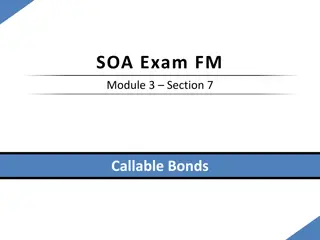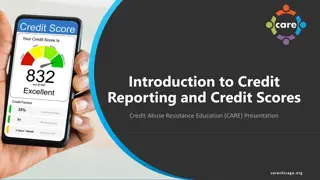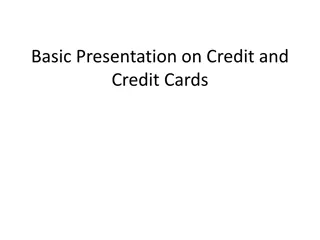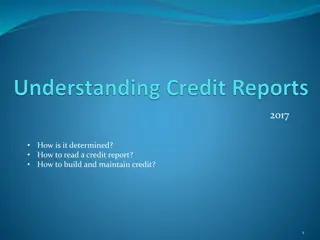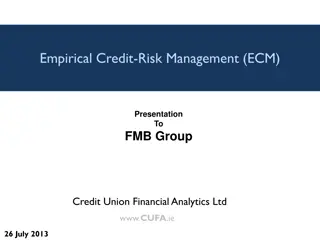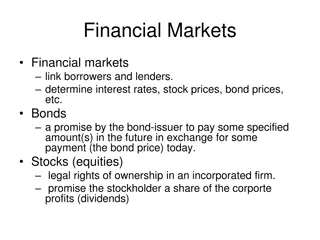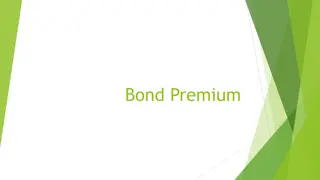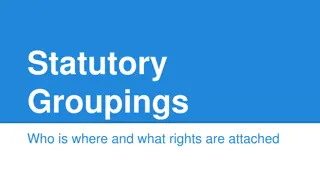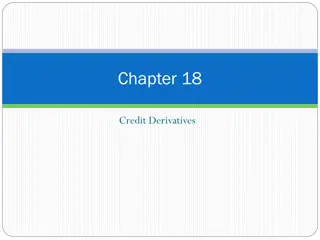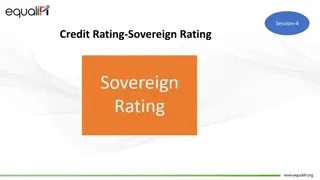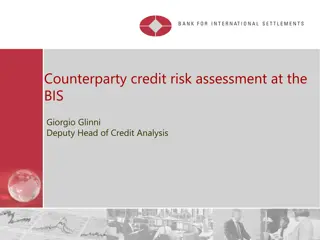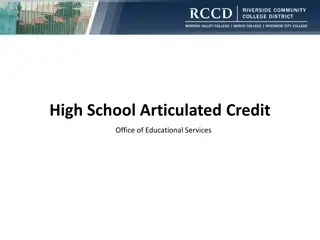Understanding Corporate Bond Ratings and Credit Risk in International Finance
Corporate bond ratings provide signals on default probability, impacting borrowing costs. Higher ratings signify lower risk and interest rates. Credit spreads measure the difference between risky bonds and risk-free assets, with risk-free assets like US Treasury bonds seen as default-free. The longevity of companies varies, highlighting the importance of managing credit risk.
Download Presentation

Please find below an Image/Link to download the presentation.
The content on the website is provided AS IS for your information and personal use only. It may not be sold, licensed, or shared on other websites without obtaining consent from the author. Download presentation by click this link. If you encounter any issues during the download, it is possible that the publisher has removed the file from their server.
E N D
Presentation Transcript
PART II - LECTURE I CORPORATE BOND, RATING AND CREDIT RISK International Finance- 2019
Some basic questions What is rating? It is a system to provide an easy to understand signal about the probability of default of a certain financial instrument and the loss caused by this default Bond ratings affect the rate of return that lenders require of the firm and the firm s cost of borrowing What is default? tricky question, it depends on the contract debt restructuring, failure to pay, bankruptcy What is loss given default? 8.2
Bond Rating In the S&P rating system AAA is the best rating. After that comes AA, A, BBB, BB, B, and CCC The corresponding Moody s ratings are Aaa, Aa, A, Baa, Ba, B, and Caa. Another provider of ratings is Fitch Bonds with ratings of BBB (or Baa) and above are considered to be investment grade Junk Bonds Debt that is rated below BBB Often, trusts and insurance companies are not permitted to invest in junk debt Michael Milken developed this market in the mid-1980s, although he was convicted of insider trading 8.3
The higher the rating the lower the interest rate paid
Credit Spread Credit Spread = difference between the Yield To Maturity on a risky bond and the Yield To Maturity of the risk-free asset Q1: what is a risk-free asset? Credit Spread = Probability of Default * Loss given Default Q2: Default needs a time horizon Q3: Is the loss time-invariant?
What is risk-free? In the US Treasury bonds: no default risk since the Treasury can print money to payoff the debt In Emerging markets ? In Euro-area ?
Default and time Companies that survive 100 years or longer are "a special and rarefied group. Jim Collins, Built to Last The average life expectancy of a big multinational corporation (Fortune 500) is 50 years. Ellen de Rooij of the Stratix Group in Amsterdam indicates that the average life expectancy of all firms, regardless of size, measured in Japan and much of Europe, is only 12.5 years.
Average Cumulative Default Rates (%) (S&P Credit Week, April 15, 1996, Table 23.2, page 627) Yrs 1 2 3 4 5 7 10 0.00 0.00 0.07 0.15 0.24 0.66 1.40 AAA 0.00 0.02 0.12 0.25 0.43 0.89 1.29 AA 0.06 0.16 0.27 0.44 0.67 1.12 2.17 A 0.18 0.44 0.72 1.27 1.78 2.99 4.34 BBB 1.06 3.48 6.12 8.68 10.97 14.46 17.73 BB 5.20 11.00 15.95 19.40 21.88 25.14 29.02 B 19.79 26.92 31.63 35.97 40.15 42.64 45.10 CCC 8.10
Example: let s start from these 2 ZCB curves Maturity (years) 1 Risk-free yield 5% Corporate bond yield 5.25% 2 5% 5.50% 3 5% 5.70% 4 5% 5.85% 5 5% 5.95% 8.11
implied losses from defaults One-year Treasury bond (principal=$1) sells for e = 0 05 1 . 0951229 . One-year corporate bond (principal=$1) sells for e = 0 0525 1 . 0948854 . or at a 0.2497% discount This indicates that the holder of a corporate bond expects to lose 0.2497% from defaults in the first year 8.12
Does Credit risk mean only default? Credit risk is not a one-dimensional problem of default It is also a problem of credit deterioration, i.e. the worsening of the rating (and then increased def.prob.) An example is constituted by mutual funds investing in Investment Grade bond. Their problem is downgrading to sub-investment grades 8.13
One-Year Transition Matrix Year End Rating BBB Init Rat AAA AAA AA A BB B CCC Def 90.81 8.33 0.68 0.06 0.12 0.00 0.00 0.00 AA 0.70 90.65 7.79 0.64 0.06 0.14 0.02 0.00 A 0.09 2.27 91.05 5.52 0.74 0.26 0.01 0.06 BBB 0.02 0.33 5.95 86.93 5.30 1.17 0.12 0.18 BB 0.03 0.14 0.67 7.73 80.53 8.84 1.00 1.06 B 0.00 0.11 0.24 0.43 6.48 83.46 4.07 5.20 CCC 0.22 0.00 0.22 1.30 2.38 11.24 64.86 19.79 Def 0.00 0.00 0.00 0.00 0.00 0.00 0.00 100
from default statistics to bond pricing we need to know, what is the default definition: changes according to the contract ISDA effort has not yet produced a standard changes according to the nature of the issuer (sovereign vs private, corporate vs bank, etc) changes according to the legislations we need to know what is the loss caused by a default changes according to financial instruments changes according to covenants changes according to legislations changes according to sectors changes according to economic cycles 8.15
Reducing Exposure to Credit Risk Set credit limits Ask counterparty to post collateral Design contract to reduce credit risk (eg margins) Include a downgrade trigger in contract use credit derivatives 8.16
Attraction of Credit Derivatives Allows credit risks to be exchanged without the underlying assets being exchanged Allows credit risks to be managed 8.17
Credit Default Swap Company A has the right to sell a reference bond for its face value to company B in the event there is a default on the bond In return, A makes periodic payments to B The reference bond is issued by a third party, C 8.18
Credit Derivatives Examples: Credit default swap Total return swap Credit spread option CDO ABS 8.19






